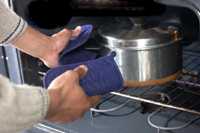Factors Affecting Safe Food Preparation by Food Workers and Managers
This page shows the study purpose, method, results, conclusions, and recommendations in plain language for the EHS-Net project titled Food Workers' Food Preparation Practices Focus Group Study.
The findings and recommendations from this project are also in fact sheet format [PDF - 274 KB].
Citations for more EHS-Net publications are available by Study Topic or by Citation.

Study Problem
Most foodborne illness outbreaks linked to restaurants are related to unsafe food handling by workers. Studies have shown that food workers often do not handle food safely. To improve worker practices, we need to know the factors that affect those practices.
Study Purpose
The purpose of this study was to describe the beliefs of workers and managers about what makes it easier or harder for them to do seven safe food-handling practices:
- Washing hands.
- Preventing contamination of food.
- Using gloves.
- Cooking food to the right temperature.
- Keeping heated food hot.
- Keeping cooled food cold.
- Reheating food to the right temperature.
Study Findings in Brief
EHS-Net asked food workers about things that made it harder to safely handle food. Workers most commonly said those things were
- Time pressure.
- Lack of or poor equipment and resources.
Study Method
Participants
Seventy food workers took part in the study. They worked at restaurants in the 2003 EHS-Net sites. They had worked in a restaurant kitchen for at least 3 months.
Data Collection
We held 11 focus groups with the workers. In each group, the study leader asked questions of four to eight workers. The questions were about the things that made it easier or harder for workers to do seven food-handling practices.
Five focus groups were with food workers who spoke English. Four focus groups were with managers who spoke English. Two focus groups were conducted in Spanish with workers whose primary language was Spanish.
Study Results
Workers identified many factors linked to each of the seven food-handling practices. Workers named some factors across several practices:
- Time pressure. Time pressure caused by high volume of business or poor staffing made it hard to do all seven safe food-handling practices.
- Equipment and resources. Equipment and resources were mentioned in discussion of all practices.
- Easy-access sinks and enough soap and gloves helped hand washing and glove use.
- Multiple color-coded cutting boards and separate work areas for different foods helped prevent the spread of germs.
- Multiple thermometers helped with proper holding, reheating, and cooling.
- Well-maintained equipment helped with proper holding, reheating, and cooling.
- Certain kinds of equipment helped with proper holding, reheating, and cooling.
- Not having enough workspace made it hard to do proper cooling and holding.
- Management and coworkers. Workers said they were more likely to safely handle food when managers and coworkers stressed food safety.
- Negative consequences. Workers were more likely to safely handle food when they knew that not doing so would lead to negative consequences.
- Food-safety education and training. Education and training are important to food safety. Several workers said it was also important to teach workers why they should engage in safe food practices.
- Restaurant procedures. Restaurant procedures helped food safety. These include recording when workers wash their hands and take food temperatures.
Study Conclusions
Several factors are linked to whether workers handle food safely. They include management and coworkers, negative effects, food safety training, and restaurant procedures. The two most common factors were time pressure and equipment and resources.
Many current efforts in food safety are focused on training. But responses by food workers show that training alone is not enough to ensure food safety. To be successful, food-safety programs must do more than give training. They must also address the full range of factors that affect food-handling practices.
Many of the factors are influenced by management. This suggests that management plays an important role in food safety. For example, managers often directly affect whether staffing is enough. The study also suggests that future food-safety plans should focus on management.
EHS-Net Recommends
These results can be used to guide future research in this area. For example, future research might focus on finding which factors have the greatest effect on food safety.
These results can guide restaurants in their attempts to improve food safety. For example, managers could review their practices and kitchens and find problems with food safety in their restaurants. They could also talk to food workers and find what problems stop them from handling food safely. Managers can then try to fix these problems.
Food-safety programs could try to better understand factors that affect food safety in restaurants in their areas. Then they could then try to help restaurants fix those factors.
Key Terms
- Focus group: groups of food workers who were asked about what made it easier or harder to handle food safely.
- Holding: keeping food at a specific temperature to reduce germ growth.
- Page last reviewed: March 23, 2017
- Page last updated: March 23, 2017
- Content source:


 ShareCompartir
ShareCompartir